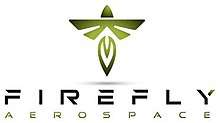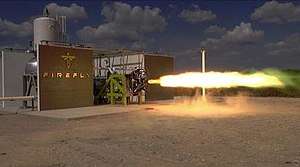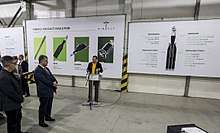Firefly Aerospace
Firefly Aerospace[3][4] is an American private aerospace firm based in Austin, Texas, that develops small and medium-sized launch vehicles for commercial launches to orbit. They are proponents of NewSpace: a movement in the aerospace industry whose objective is to increase access to space through innovative technical advances resulting in a reduction of launch cost and the lessening of regulations and logistical restrictions associated with dependence on national space institutions.[5]
 | |
Formerly | Firefly Space Systems |
|---|---|
| Industry | Aerospace |
| Founded | March 2017 |
| Founders | Max Polyakov and Tom Markusic |
| Headquarters | , United States |
Key people | Tom Markusic, CEO |
Number of employees | 180 in the USA, 160 in Ukraine[1][2] |
| Website | firefly |
The company was formed when former Firefly Space Systems assets were acquired by EOS Launcher in March 2017, which was then renamed Firefly Aerospace. Firefly Aerospace is wholly owned by Noosphere Ventures,[6][7][8][9] the strategic venture arm of Noosphere Global.[10][11][12] Firefly Aerospace is now working on the Alpha 2.0 launch vehicle which has a significantly larger payload capability than the previous Alpha developed by Firefly Space Systems. It aims to place a 1000 kg payload into a low Earth orbit and 600 kg into a Sun-synchronous orbit.[12] The restructured company has about 140 employees.[13][4]
History
Firefly Space Systems
Early growth
Firefly Space Systems was formed in January 2014[14] by Tom Markusic, P.J. King and Michael Blum [15] and a small group of entrepreneurs who self-funded the company. In September 2014, Firefly announced it would move its headquarters from Hawthorne, California to Austin-suburb Cedar Park, Texas.[16] By November 2014, it had relocated to Texas.[5] It grew to 30 employees by August 2014 and 43 employees by November 2014.[5] Firefly had office and engineering facilities in Cedar Park, Texas and Hawthorne, California and purchased 215 acres (87 ha) of land for an engine test and manufacturing[17] facility in Briggs, Texas, 50 miles (80 km) north of Austin.[18]
Tom Markusic has a background in propulsion engineering, and has worked at other NewSpace companies including SpaceX — where he was manager of the SpaceX Texas Rocket Test Facility — and also held senior posts at Virgin Galactic and Blue Origin.[18] The company name came to Markusic while sitting on his back porch watching fireflies and realizing that in the future the sky above Earth might look like that as spacecraft ferried people to Mars.[5]

In 2014, Firefly purchased fiber-winding equipment for manufacturing composite cryotanks that will be built using an out-of-autoclave process. Prototype tanks were tested at Marshall Space Flight Center in mid-2014.[18]
The Firefly Alpha design was revealed in July 2014.[14]As of November 2014 Firefly's objective was to be cash-flow positive by 2018, based on anticipated small-satellite business.[5] Firefly had signed an agreement with Space Florida to launch from the Florida "Space Coast".
Firefly performed their first hot-fire engine test of the "Firefly Rocket Engine Research 1" (FRE-R1) on 10 September 2015.[19][20] The initial demonstration launch of the Firefly Alpha was planned to be as early as 2016.[21]
Litigation and closure
In December 2014, Tom Markusic's former employer Virgin Galactic alleged he had illegally provided Virgin intellectual property to the Alpha development team. Virgin also alleged that Markusic had "destroyed storage devices, disposed of computers, and reformatted hard drives to cover the tracks of his misappropriation of Virgin Galactic information".[22] In August 2016, an independent arbitrator confirmed that Markusic had destroyed evidence. Thereafter, a major European investor backed down, leaving Firefly without sufficient money to proceed. The company furloughed its entire staff in October 2016. According to Markusic, the investor's drawback was not related to the litigation but to Brexit.[23] Within the same month, Virgin Orbit filed suit in Los Angeles County Superior Court against Firefly and two of its officers.[24] By 1 December 2016, Firefly Space Systems had permanently ceased engineering work.[25]
In March 2017, it was announced that "virtually all" of the assets of Firefly would be sold at auction, organized by EOS Launcher, Inc., who had previously bought a US$1 million promissory note issued by Firefly to Space Florida and induced a foreclosure.[26][27]
Firefly Aerospace
After going bankrupt and being liquidated in March 2017, the company was re-created as Firefly Aerospace by Noosphere Ventures, who bought out the assets of former Firefly Space Systems.[3] The owner of Noosphere Ventures, Max Polyakov, committed to fully fund Firefly through at least its first two launches.[28] The plans for engine development were significantly altered by the new management, and the revised Alpha vehicle features a pump-fed engine and removes the aerospike configuration.[11] The reorganization has delayed development by approximately a year, with the first launch expected in the fourth quarter of 2019.[29]
Development of engines and structures has resumed and Firefly Aerospace has performed multiple hot-fire tests of its Lightning-1 second stage engine on its existing horizontal test stand. A vertical stage test stand is nearing completion and stage testing is expected to begin in the second half of 2018.
On 17 May 2018, Firefly Aerospace opened a Research and Development (R&D) center in the city of Dnipro, Ukraine. The Firefly R&D center was announced to become over time a place of work for more than 150 employees, and is equipped with the largest 3D-printer in Ukraine, intended for industrial manufacturing of high-quality metal parts.[1]
On 10 October 2018, Firefly Aerospace and smallsat developer York Space Systems announced a partnership to offer customers a combined package of satellite and launch services.[30]
In November 2018, it was announced that NASA selected Firefly Aerospace as one of nine companies able to bid at the Commercial Lunar Payload Services,[31] where the company will be proposing a robotic lunar lander called Firefly Genesis.[32]
In February 2019, the company announced that it would develop manufacturing facilities and a launch site at Cape Canaveral.[33] They have leased a private launch pad in Florida — the former Space Launch Complex 20 (SLC-20) which had been used by the US Air Force in the 1950s through 1996 — from the US government and they also have a similar lease arrangement on the US West Coast.[34]
Launch vehicles

Firefly Alpha
The Alpha vehicle developed by Firefly Aerospace is an expendable launch vehicle with 1,000 kilograms (2,200 lb) payload capability to low Earth orbit and 600 kilograms (1,300 lb) to Sun-synchronous orbit. Projected launch cost is US$15 million per launch. Alpha is designed to compete with vehicles like the Polar Satellite Launch Vehicle.[12]
It utilizes Reaver-1 and Lightning-1 engines and a lightweight carbon composite structure to reduce launch weight, resulting in improved payload fraction.[35]
Firefly Beta
Firefly Beta is a launch vehicle concept originally planned to consist of three Alpha cores strapped together.[36] However, in October 2019, Firefly announced a partnership with Aerojet Rocketdyne to develop a single core rocket powered by Rocketdyne's AR1 engine.[37]
Genesis lunar lander
On 9 June 2019, it was announced that Firefly Aerospace signed an agreement with Israel Aerospace Industries (IAI) that owns the intellectual property of the Beresheet lunar lander design.[40] Firefly plans to build a lunar lander based on Beresheet that would be called Genesis.[40][41][42] Genesis will be proposed to NASA's Commercial Lunar Payload Services (CLPS) to deliver payloads to the surface of the Moon.[40][41] If selected, Firefly Genesis would be launched with a Firefly Beta rocket,[41] or a Falcon 9 rocket[42] in late 2022.[43]
Production
Firefly headquarters and factory are located in Cedar Park, Texas.[44] The company has access to about 50,000 ft2 of manufacturing facilities for building composite and metallic components in-house.[11] Firefly will use leased launch sites in California (Vandenberg Air Force Base) and in Florida (SLC-20).[34][44]
See also
References
- Firefly Aerospace Opens Research and Development Center in Dnipro, Ukraine - Firefly Aerospace
- "8 ракет в год. Кто задумал возродить космический бизнес в Украине" [8 rockets per year. Who conceived to revive the space business in Ukraine]. ЛIГА.Tech (in Russian). 29 December 2018.
- Once Grounded by Bankruptcy, Firefly Aerospace Appears Ready to Re-Launch
- "Staring at Firefly Aerospace's hot rocket-engine flames in a Texas pasture". 3 April 2018.
- Hutchinson, Lee (30 November 2014). "Firefly Space Systems charges full-speed toward low Earth orbit". ars Technica. Archived from the original on 3 December 2014. Retrieved 1 December 2014.
- "Noosphere Ventures USA, Inc.: Private Company Information - Bloomberg". www.bloomberg.com. Retrieved 27 March 2018.
- "Noosphere Ventures | Technology Knowledge Humanity". noosphereventures.com. Retrieved 27 March 2018.
- "Noosphere Ventures | Crunchbase". Crunchbase. Retrieved 27 March 2018.
- "Ukrainian Entrepreneur Ventures From Online Dating to Space – Parabolic Arc". www.parabolicarc.com. Retrieved 27 March 2018.
- "Noosphere Global Asset Management".
- Firefly Re-Emerges With Upgraded Alpha Rocket Design
- "Firefly Alpha". fireflyspace.com. Retrieved 30 May 2018.
- "Firefly Space Social Media comment on new company direction". Firefly Space. Retrieved 21 September 2017 – via Facebook.
- Aron, Jacob (8 July 2014). "Next generation of space cowboys get ready to fly". Newscientist.com. Retrieved 5 October 2014.
- Spacevidcast (now TMRO -- see new channel) (24 August 2014). "Firefly Space - 7.26" – via YouTube.
- "Hawthorne-based rocket company to move to Texas". Daily Breeze. 14 September 2014. Retrieved 3 December 2014.
- Episode 15: DOWNLINK--Firefly Space Systems — Interview. The Orbital Mechanics. 23 June 2015. Retrieved 24 June 2015.
- Morring, Frank, Jr. (25 August 2014). "SpaceX Alum Goes After Falcon 1 Market With Firefly". Aviation Week. Archived from the original on 3 December 2014. Retrieved 17 October 2014.
- First Rocket Engine Test a Success for Firefly Space Systems, press release, 10 September 2015, accessed 17 December 2015.
- Wall, Mike (10 September 2015). "New Firefly Rocket Engine Passes Big Test, Will Launch Small Satellites". Space.com. Retrieved 8 January 2016.
- New Alpha rocket will launch test flights from KSC, Florida Today, 15 October 2015, accessed 17 December 2015.
- Messier, Doug (12 January 2016). "Former Propulsion Chief Accuses Virgin Galactic of Lying About SpaceShipTwo's Safety, Performance". Parabolic Arc. Retrieved 13 May 2019.
- Foust, Jeff (3 October 2016). "Firefly Space Systems furloughs staff after investor backs out". SpaceNews. Retrieved 3 October 2016.
- Messier, Doug (25 October 2016). "Virgin Galactic Sues Firefly, Officers for Alleged Misappropriation of Trade Secrets". Parabolic Arc. Retrieved 13 May 2019.
- "Was a good place while it lasted"
- "Firefly Space Systems assets to be sold - SpaceNews.com". SpaceNews.com. 15 March 2017. Retrieved 15 March 2017.
- Messier, Doug (5 June 2017). "Celebrate Independence Day by Buying a Rocket Test Facility". Parabolic Arc. Retrieved 13 May 2019.
- Berger, Eric (11 February 2019). "After a remarkable resurrection, Firefly may reach space in 2019". Ars Technica. Retrieved 11 February 2019.
- One of the young space firms that are sponsored by Max Polyakov is Firefly Aerospace
- Firefly Aerospace and York Space Systems partner to provide integrated satellite solutions Jeff Foust, Space News. 10 October 2018.
- Daines, Gary (29 November 2018). "Firefly Aerospace Concept for Launch Vehicle with Moon Lander". NASA. Retrieved 29 January 2019.
- Firefly to partner with IAI on lunar lander. Jeff Foust, Space News. 9 July 2019.
- Berger, Eric (22 February 2019). "Firefly planning a major rocket assembly and launch facility in Florida". Ars Technica.
- Resurrected Firefly Aerospace will take over a launch site at busy Florida spaceport, 22 February 2019.
- "Alpha Payload User's Guide" (PDF). www.fireflyspace.com. 3 April 2018.
- Clark, Stephen (2 May 2018). "Firefly's commercial satellite launcher to use Delta 2 pad at Vandenberg". Spaceflight Now. Retrieved 3 May 2018.
- Clark, Stephen (28 October 2019). "Aerojet Rocketdyne, Firefly to collaborate on propulsion". Spaceflight Now. Retrieved 28 October 2019.
- Firefly partners with Aerojet Rocketdyne, mulls AR1 engine for Beta launch vehicle. Caleb Henry, Space News. 18 October 2019.
- Firefly Gamma. Firefly Aerospace. Accessed on 30 November 2019.
- Firefly to partner with IAI on lunar lander. Jeff Foust, Space News. 9 July 2019.
- Israel's failed lunar lander will live on in the design of Firefly Aerospace's new Moon spacecraft. Loren Grush, The Verge. 9 July 2019.
- Firefly Genesis. Firefly Aerospace. Accessed on 13 September 2019.
- https://spaceflightnow.com/2020/04/01/in-parallel-with-rocket-development-firefly-offers-details-on-lunar-lander-initiative/ - 2 April 2020
- FOX. "Austin-area aerospace company selected by NASA for Commercial Lunar Payload Services Contract". KTBC. Retrieved 29 January 2019.
External links
- Firefly Space Systems, overview video, October 2015.
- Profile|Thomas Markusic, Founder and Chief Executive, Firefly Space Systems, by Dan Leone; 13 October 2014; spacenews.com